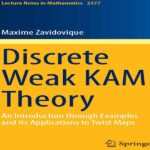- عنوان کتاب: Quantum Mechanics
- نویسنده: Sergio Cecotti
- حوزه: مکانیک کوانتومی
- سال انتشار: 2025
- تعداد صفحه: 653
- زبان اصلی: انگلیسی
- نوع فایل: pdf
- حجم فایل: 8.23 مگابایت
این سومین کتاب درسی است که از سخنرانیهای نویسنده در رشته فیزیک در کالج کیوجن، موسسه ممتاز چینی برای بااستعدادترین دانشجویان ریاضی در کشور، تهیه شده است. دانشجویان ممتاز به کتابهای درسی ممتاز نیاز دارند: هدف، نوشتن کتابهای درسی مقدماتی و مستقل است، اما در عین حال، دیدگاهی عمیقتر و مدرنتر در مورد موضوع ارائه میدهد. این کتاب که برای دانشجویان بااستعداد ریاضی نوشته شده است، قصد دارد مکانیک کوانتومی را به شیوهای دقیق و ظریف از نظر ریاضی ارائه دهد، ضمن اینکه بینش فیزیکی در مورد معنا و مفاهیم عبارات رسمی ارائه میدهد. کالج کیوجن میخواهد دانشجویانش ریاضیدانان ماهری شوند، اما در عین حال «شهود فیزیکی» خوبی نیز در خود پرورش دهند. برخلاف کتابهای درسی معمول مکانیک کوانتومی که گرایش ریاضی دارند، در این کتاب، آنالیز تابعی در حداقل خود نگه داشته شده است، در حالی که بر جنبههای جبری، هندسی و نظری نمایش تأکید میشود، از جمله برخی داستانهای عمیق که هرگز در کتاب درسی مکانیک کوانتومی گفته نشده است، مانند: کاربرد نظریه پیکارد-وسیو از گروههای دیفرانسیل گالوا در معادله شرودینگر، فرمولبندی پروفر از مسائل اشتورم-لیوویل، رابطه قضیه ریمان-روخ با مکانیک کوانتومی در حضور میدانهای مغناطیسی، تناظر ریمان-هیلبرت در مقابل اثر بوهم-آهارونوف، نظریه چندجملهایهای هارمونیک، استفاده از فضاهای هیلبرت توابع هولومورفیک، مبدا هندسی فاز بری و غیره. ابزارهای ریاضی که معرفی میکنیم، تأکید کتاب را منعکس میکنند: برخلاف اکثر مقدمههای فیزیکمحور مکانیک کوانتومی، ما به جای طرحهای تقریبی (که با این وجود در فصل 8 برای کامل بودن توضیح داده شدهاند) بر روشهای دقیق تمرکز میکنیم. بسیاری از تکنیکها و مثالهایی که مورد بحث قرار میدهیم، هرگز بخشی از یک بررسی مقدماتی از موضوع نبودهاند. به عنوان مثال، میتوان به چند نمونه از این موارد اشاره کرد: مشابه سطوح لاندائو برای یک ذره باردار که در صفحه هذلولی حرکت میکند، یا در میدان یک تکقطبی، یا حرکت آزاد در یک مثلث کروی. نوسانگر هماهنگ به عنوان نمونهای از چندین روش دقیق و تعامل متقابل آنها استفاده میشود: در کتاب درسی بیش از دوازده راه حل برای نوسانگر هماهنگ با استفاده از فرمولبندیهای متنوع فضای هیلبرت و همچنین تعدادی از نمایشهای انتگرال مسیر جایگزین وجود دارد. ذرهای که در پتانسیل مرکزی −α/r حرکت میکند. به چهار روش مختلف (از جمله انتگرال مسیر دقیق) در تعداد دلخواهی از ابعاد فضایی، نه فقط در d = 3 استاندارد، حل میشود. این کار برای نشان دادن ساختارهای عمیق و ظریف زیربنایی این سیستم کوانتومی بنیادی انجام میشود، ساختارهایی که با نگاه به حالت خاص سه بعدی نمیتوان آنها را به طور کامل درک کرد. اکثر روشهای دقیق در هیچ کتاب درسی مکانیک کوانتومی شرح داده نشدهاند و برخی کاملاً جدید به نظر میرسند، به عنوان مثال، محاسبه دقیق انتگرالهای مسیر غیر گاوسی با روشهای استقرایی. ارائه نمایش کلی شرودینگر به زبان هندسه دیفرانسیل به ما این امکان را میدهد که نسخهای کلیتر و صریحتر از قضیه نوتر را برای سیستمهای کوانتومی با تقارن گروه لی بیان و اثبات کنیم. در زمینه تقارن در فیزیک کوانتومی، ابرتقارن و نظریه نمایش آن (شامل شاخص ویتن و ارتباط آن با نظریه مورس) را در فرمولبندی فضای هیلبرت و همچنین در انتگرال مسیر، از جمله ارتباطات آن با حساب دیفرانسیل تصادفی، معرفی میکنیم. ابرتقارن همچنین به عنوان یک ترفند ریاضی برای حل سیستمهای کوانتومی غیر ابرتقارنی مورد استفاده قرار میگیرد. انتگرالهای مسیر از چندین دیدگاه و با تکنیکهای متنوع با جزئیات کامل معرفی و مطالعه میشوند. فصل 6 شامل فهرستی طولانی از روشهای دقیق برای محاسبه آنهاست. طرحهای تقریبی مختلفی برای محاسبه انتگرالهای مسیر در فصل 8 شرح داده شده است، از جمله استخراج دقیق گاز رقیق اینستانتون که بحثهای کتاب درسی آن منبع اصلی انتقاد در ادبیات بوده است. مقدمهای بر سیستمهای کوانتومی باز، درهمتنیدگی، آنتروپی فون نویمان، اطلاعات کوانتومی و همه اینها در فصل 7 ارائه شده است. در حالی که بحث به جنبههای اساسی محدود شده است، تلاشی برای دقت وجود دارد و مانند بقیه کتاب، بر جنبههای جبری و هندسی نظریه، از جمله هندسه زیبای بورس از فضای حالتهای کوانتومی در یک سیستم کوانتومی باز، تأکید شده است.
This is the third textbook arising from the author’s lectures of Physics at the Qiuzhen College, the elite Chinese Institution for the most talented math students in the country. Elite students require elite textbooks: the ambition is to write textbooks that are introductory and self-contained but, at the same time, present a deeper and more modern perspective on the subject. Being addressed to talented math students, this book aims to present Quantum Mechanics in a mathematically precise and elegant way, while providing physical insight on the meaning and implications of the formal statements. The Qiuzhen College wants its students to become accomplished mathematicians but also to develop a good “physical intuition.” Contrary to typical Quantum Mechanics textbooks with a mathematical leaning, in this book Functional Analysis is kept at its minimum, while stressing the Algebraic, Geometric, and Representation Theoretic aspects, including some deep stories never told in Quantum Mechanics textbook such as: the application of the Picard-Vessiot theory of differential Galois groups to the Schrödinger equation, the Prüfer formulation of Sturm-Liouville problems, the relation of the Riemann-Roch theorem with Quantum Mechanics in presence of magnetic fields, the Riemann- Hilbert correspondence vs. the Bohm-Aharonov effect, the theory of harmonic polynomials, the use of Hilbert spaces of holomorphic functions, the geometric origin of the Berry phase, and so on. The math tools we introduce reflect the emphasis of the book: contrary to most of the physically oriented introductions to Quantum Mechanics, we focus on the exact methods rather than on approximation schemes (which are nevertheless described in Chap. 8 for the sake of completeness). Many of the techniques and examples we discuss have never been part of an introductory treatment of the subject. To name a few such examples: the analogue of the Landau levels for a charged particle moving in the hyperbolic plane, or in the field of a monopole, or the free motion in a spherical triangle. The harmonic oscillator is used as an illustration of the several exact methods and their mutual interplay: in the textbook there are more than a dozen solutions of the harmonic oscillator using diverse Hilbert space formulations as well as a number of alternative path integral representations. The particle moving in the central potential −α/r. is solved in four different ways (including exact path integral) in an arbitrary number of spatial dimensions, not just in the standard d =3.. This is done to illustrate the deep elegant structures underlying this fundamental quantum system, structures that cannot be fully appreciated looking to just the special case of three dimensions. Most of the exact methods are not described in any Quantum Mechanics textbook and some seem to be totally novel, as, for instance, the exact computation of non-Gaussian path integrals by inductive methods. The presentation of the general Schrödinger representation in the language of Differential Geometry allows us to state and prove a more general and explicit version of the Noether theorem for quantum systems with a Lie group symmetry. In the context of symmetry in Quantum Physics, we introduce supersymmetry and its Representation Theory (including the Witten index and its relation to Morse theory) in the Hilbert space formulation as well as in the path integral one, including its connections with stochastic differential calculus. Supersymmetry is also exploited as a math trick to solve non-supersymmetric quantum systems. Path integrals are introduced and studied in great detail from several viewpoints and with diverse techniques. Chapter 6 contains a long list of exact methods to compute them. Various approximate schemes to compute path integrals are described in Chap. 8, including a rigorous derivation of the dilute instanton gas whose textbook treatments had been a major source of criticism in the literature. A primer in open quantum systems, entanglement, von Neumann entropy, Quantum Information, and all that, is given in Chap. 7. While the treatment is limited to the basic aspects, there is an effort to precision, and, as in the rest of the book, an emphasis on the algebraic and geometric aspects of the theory, including the beautiful Bures geometry of the space of quantum states in an open quantum system.
این کتاب را میتوانید از لینک زیر بصورت رایگان دانلود کنید:
Download: Quantum Mechanics




































نظرات کاربران